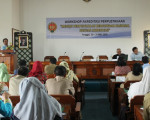Writer:
Hendrikus Franz Josef, M.Si
Regional Library and Archive Office of Yogyakarta Special Region
2019
Abstract
The compact disk cataloging is the process of making a catalog as a means of retrieving information about the compact source electronic library information, wherein the catalog contains important data contained in library collection materials both physical characteristics (descriptive cataloging) and intellectual content (cataloging subjects). So cataloging is a process of decision making that requires the ability of catalogers to interpret andapplicable standards so that important data from recorded library material becomes a catalog. Rules for cataloging Compact disks in the AACR2 regulations are part of the electronic cataloging rules, which include data, programs, or a combination of both data and programs. Electronic source Generally include components with characteristics commonly found in various materials, so it is often necessary to check compliance with other material cataloging regulations. For cataloging purposes, electronic sources can be treated in one of two ways, depending on whether the access is direct or remote (in the network). Directunderstanding is the physical material can be described (eg CD) the material can be read by a computer. While the understanding of remote access is that the physical cannot be described, but can be handled by connecting a computer network system.
Preliminary
Cataloging of printed library materials such as books is well known to us. Therefore, in this paper we will discuss compact disk cataloging. Cataloging of compact disks in the Anglo-American Cataloging Rules (AACR2) provides description rules which are grouped into electronic source library (e-Resources) material regulations. The understanding of electronic source library materials according to AACR2 is library materials that are operated in their use using devices that are directly connected to the computer, for that the library that will collect materials. This compact disk library must provide a CD-drive to read the CD. This paper is one of the efforts aimed at making library staff and librarians expected to be able to understand how to create an electronic source catalog or make a means of re-meeting system according to applicable regulations, especially for compact disk library materials which are now increasingly in demand. The regulations in cataloging that will be used are based on the regulations set in the 1998 issue of the Anglo-American Cataloguing Rules (AACR2) and the 2012 Indonesian Cataloging Regulations.
.
How To Make CD Catalog Printing
The main source of information for electronic sources is the source itself. The information is presented formally as stated in the screen title, main menu, program statement, exposure to the information that appears first. In addition, it can also be taken from physical materials or labels, including information. which is printed or processed for use. If the information at this source varies with the level of completeness, then select it the source that provides the most complete information. If the required information is not available from the source itself, then take it from the following sources: 1. Printed or attached documentation or other material included (for example a publisher's letter, a quiet file of something, a publisher's webpage about electronic sources; 2. Information printed on accompanying materials/packaging issued by the publisher, distributor, and so on.
Bibliographic data recorded in electronic sources consists of 8 areas, namely:
1. Area of Title and Declaration of Responsibility
2. Regional Edition
3. Special Regional Details About Material / Type of Issuance
4. Issuance Area
5. Physical Description Area
6. Regional Series
7. Regional Notes
8. Regional Standard Number
1. Area of Title and Declaration of Responsibility:
1.1. Punctuation
1.1. Title Actually
1.2. General Material Marking
1.3. Parallel Title
1.4. Other Title Information
1.5. Statement of Responsibility
1.1. Punctuation
Start the supplement title or section title with a period (.)
Include common material markings between square brackets ([ ])
Start each parallel title with the same sign (=)
Begin each unity with other title information with a colon (:)
Start the first statement of responsibility with a slash (/)
and the next statement with a semicolon (;)
1.2. Title Actually
Include the actual title according to the word, the spelling arrangement
used in the main source of information.
Collection oftropical birds of Indonesia
International Relation Science
Global Economic management
Always state the actual title in the note, if the title is available then state the source of the title given in the note.
1.3. General Material Marking
Include general material markings in square brackets after the actual title
Collection oftropical birds of Indonesia (electronic source)
International Relation Science (Electronic source)
Global Economic management Eelectronic source)
1.4. Parallel Title
Include a parallel title after labeling the general material, with include an equal sign.
Economic Research [electronic source] = Economic Research
1.5. Other Title Information
Include other title information if available after labeling the material general by including a colon 4
Office 2016 [electronic source]: modeling lowland rice
International Relation Science[electronic source]: adding
value for customers
1.6. Statement of Responsibility
Include statements of responsibility relating to people or agency that has an important role in creating file contents
Office2016 [electronic source]: modeling lowland rice / by
Adi Nugroho . . [et al.]
International Relation Science[electronic source]: adding
value for customers / by Hoffmann, Stanley.
Global Economic management [electronic source] / by Goodman, John B., and Louis W. Pauly
Regional Edition
2.1. Punctuation
2.2. Edition Statement
2.3. Statement of Responsibility relating to the edition
2.1. Punctuation
This area is preceded by a space line spacing (. ─)
2.2. Edition Statement
Include the issue of a particular edition of an electronic source
which contains differences from other editions.
Ed. Rev.
Version 3. 10
Version 9
2.3 Statement of responsibility
The statement of responsibility is first for certain editions beginning with slashes, and statements further responsibilities begin with a semicolon
3. Special Details Areas About Materials
3.1. Punctuation
3.2. Source Type and Capacity
3.3. Source Expansion
3.1. Punctuation
This area is preceded by a space line spacing (. ─)
List each statement regarding the number of listings
the statement is between square brackets [ ]
Start the statement with the number of listings with a colon when amount to follow 3.2. Source Type and Capacity List the types of electronic sources that are being cataloged, use one of the following terms:
Data
Program
Data and program the number of files
3.3. Source Expansion
If information is available, then state the number of files, the listing which shows the reach and or other details. If it is available in concise form, then omit the statement capacity.
Electronic data (1 file: 350 listings)
Electronic data (1 file: 1.2 megabytes)
Program (1 file: 200 statements)
Electronic data (2 files: 800, 1250 listings) and
Computer programs (3 files: 7260, 3490, 5076 bytes)
4. Issuance Area
4.1. Punctuation
4.2. Place of Issuance
4.3. Publisher Name
4.4. Publication Year
4.1. Punctuation
Start this area with the space dotted line (. ─)
Start the second place of publication with a semicolon (;)
Start the publisher's name with a colon (:)
Start the year of publication with commas (,)
4.2. Place of Issuance
List the place / city of issue or place of distributor, beginning
with a space line spacing (. ─)
Do not list places for electronic sources
unpublished, and do not list [s.l.]
4.3. Publisher Name
Enter the publisher's name, starting with a colon
Do not list places for electronic sources
unpublished, and do not include [s.n.] 6
4.4. Publication Year
List the year of publication, comma with a comma, and include it
year of manufacture for unpublished electronic sources.
New York: Pearson Education, 2008
New Jersey: Prentice Hall, 2001
Los Banos: International Rice Research Institute, 2001
5. Physical Description Area
5.1. Punctuation
5.2. Number of Physical Units
5.3. Other Details About Physical
5.4. Dimension
5.5. Material Included
5.1. Punctuation
Start this area with the space dotted line (. ─) Or a new paragraph
Start other physical details with a colon (:)
Begin dimensions with semicolons (;)
Begin each statement of material included with a + sign
5.2. Number of Physical Units
Enter the number of physical units by stating the part number
with arabic numbers
1 Compact disk
1 CD-Rom
1 DVD Rom
5.3. Other Details About Physical
If the electronic source is declared to contain noise, then
include the sound term.
When electronic sources display in two or more colors
then include colored terms
1 Compact disk: make a sound
5.4. Dimension
List dimensions beginning with a semicolon
1 computer diskette: color; 5 ½ in
1 Compact disk: color: 4.72 in7
5.5 Materials Included
Include details of the ingredients included starting with +
1 CD-Rom: colored; 4.72 in + 1 instructions for use
1 Compact disk: color: 4.72 in + textbook
1 Compect disk: make a sound; 4.72 in + 7 maps
6. Regional Series
6.1. Punctuation
6.2. Series Statement
6.1. Punctuation
Start this area with the space dotted line (. ─)
Place each series statement between the brackets (())
6.2. Series Statement
Include a series in this area if present in the document
is being described. . ─ (Indonesian general election study series; no. 3)
7. Regional Notes
7.1. Punctuation
7.2. Note
7.3. System Requirements
7.4. Original Title Source
7.5. Dissertation
7.6. Hearing
7.7. Other Formats
7.8. Described Works
7.1. Punctuation
Start each note with a space dotted line (. ─) or start with a new paragraph
7.2. Note
Make notes as stated in the regulations, howeverstate the special note first if it has been setthat note is very important.
7.3. System Requirements
Make notes about the system requirements if information
available System requirements: Windows 10, Windows 8,Wwindows 7, Vista
System requirements: Microsoft Windows: Vista, Windows 98 SE,
2000, or XP.
7.4. Original Title Source
Provide the actual title source Title in the manual: Modern Compiler Design
Title in textbook
7.5. Dissertation / Thesis
If the work described is a dissertation or thesis,
then make a note as follows:
Dissertation (Doctor). ─ The Hebrew University of Jjerusalem, 2019
Thesis (Masters). ─ The Hebrew University of Jjerusalem, 2019.
7.6. Hearing
Make a brief note about the intended audience, or level intellectual property of the work if this information is stated in the work that, Only for use by medical practitioners.
7.7. Other Formats
State the details of other formats of the contents of the work that you have done circulated. Data published are also in printed form and micro form.
8. Regional Standard Number
8.1. Punctuation
8.2. Standard Number
8.3. Qualification
8.1. Punctuation
Start this area with dots, spaces, space lines (. ─) or start with a new paragraph.
8.2. Standard Number
Enter the International Standard Book Number (ISBN) or ISBN: 971 22 0177 7 (CD): Rp. 550,000
Qualification .Add qualifications to standard numbers
ISBN: 9712201777: $ 49.00 ($ 19.00 for students).
Conclusion
So CD cataloging is very useful in the context of identifying CD collections and suggesting rediscovering CDs in the service process to users. The function of the CD catalog is as follows: 1. Show the place of the CD by using classification number symbols in the form of a dial number; 2. List all the CDs in alphabetical order by the name of the author, title of the book or the subject of the book in one library-specific place to facilitate the search for the necessary entries. 3. Make it easy to find CDs in the library with only one of the complete list of CDs in question. The catalog is the key to knowing the contents of the collection from the library itself, including: a. To give a clear picture to the users of library services about the CD collection that is owned and owned by a library. b. To help library users in getting the required CDs precisely and quickly. c. So that library users can easily get the library materials they want. d. As a means of selecting theright CD to get the information needed. e. The CD catalog serves as the representative of the CD that provides complete information about the characteristics of the CD. f. The CD catalog functions as an "instrument of communication," which informs the library collection CD.
In order for the CD catalog to function as fully as possible,there are a number of things that need to be considered, namely: 1. The library CD catalog must contain all the CD features; 2. The library CD catalog must be flexible; 3. The CD library catalog must be arranged systematically so that it can be easily utilized; 4. The library CD catalog is made economically and properly maintained; 5. Librarians should provide user instructions on the use of the catalog so that users can use it as optimal as possible; 6. Make a catalog of various forms such as the author's catalog, title catalog, subject catalog, classification of subject catalogs to facilitate identification.
Bibliography
Anglo-American cataloguing Rules. 2nd edition, 1998 revision.
Library Association, 1998;
Chan, Lois Mai, Instructional materials used in teaching cataloging and classification, Cataloging & Classification quarterly 7.4, 1987;
Himawan, Deden dan Yulia, Yuyu, Pengkatalogan Sumber Elektronik, Bahan Diklat Calon Pustakawan Tingkat Ahli, Bogor, 2008;
Marcella, Rita, and Arthur Maltby, The future of Classification, Routledge, 2017;
Witt, Maria, Cataloguing CD-ROMs Using the ISBD (ER) Rules-Example of a French Public Library (Mediatheque de la Cite des Sciences et de l'industrie in Paris), Cataloging & Classification Quarterly 28.1, 2000.
Perpustakaan Lainnya
 Kunjungan Badan Perpustakaan dan Arsip Daerah Kabupaten Banyumas ke BPAD DIY
Kunjungan Badan Perpustakaan dan Arsip Daerah Kabupaten Banyumas ke BPAD DIY
Kamis, 18 Februari 2016, Kantor Kearsipan Dinamis dan Statis mendapat kunjungan dari Perpustakaan Dan Arsip Daerah Kabupaten...
 Pemasyarakatan Budaya Jawa dengan Tema “Maca Geguritan Amrih dadi Tontonan”
Pemasyarakatan Budaya Jawa dengan Tema “Maca Geguritan Amrih dadi Tontonan”
BPAD DIY menyelenggarakan PemasyarakatanBudaya Jawa dengan tema ‘Maca geguritan Amrih dadi Tontonan’ pada hari Selasa,14 April...
 Workshop Akreditas perpustakaan
Workshop Akreditas perpustakaan
Senin 30 Mei 2016 telah dilaksanakan pembukaan workshopAkreditas perpustakaan dengan tema menuju perpustakaan berstandar nasional...
 Kegiatan penutupan peringatan Hari Kunjung Perpustakaan
Kegiatan penutupan peringatan Hari Kunjung Perpustakaan
Rabu 19 September 2018 merupakan puncak peringatan Hari Kunjung Perpustakaan di Grhatama Pustaka . Adapun kegiatan yang...

 Penyerahan Buku KCKR dari Lintang Pustaka Utama
Penyerahan Buku KCKR dari Lintang Pustaka Utama